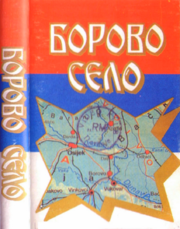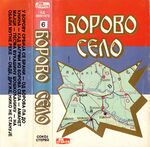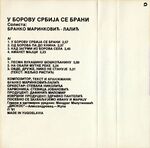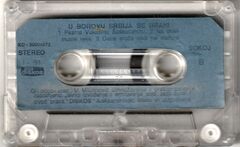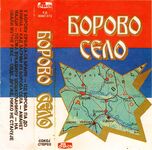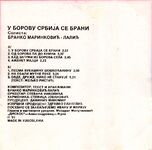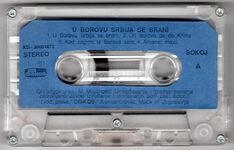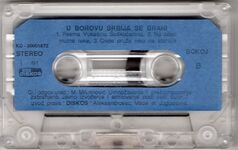Borovo Selo: Difference between revisions
BalkanMapper (talk | contribs) No edit summary |
BalkanMapper (talk | contribs) (minor edit) |
||
| Line 13: | Line 13: | ||
}} | }} | ||
'''''Borovo Selo''''' (Serbian Cyrillic: Борово Село) is the debut album of Serb war singer Branko Marinković Lalić, released in 1991 by Diskos. | '''''Borovo Selo''''' (Serbian Cyrillic: Борово Село), also known as ''U Borovu Srbija se brani'' (Serbian Cyrillic: У Борову Србија се Брани, lit. In Borovo, Serbia defends itself) is the debut album of Serb war singer Branko Marinković -Lalić, released in 1991 by Diskos. | ||
== Background == | == Background == | ||
Following the multi-party elections held in Croatia on April 22nd, 1990, the Croatian Democratic Union (HDZ) would win, with its political intentions being independence from Yugoslavia. With the political situation in the SR Croatia deteriorating rapidly and a rebirth of Croat nationalism, the Serb population feared for their safety and wanted their own independence from Croatia. The prelude to the Croatian War, the Log Revolution, came to be on August 17th, 1990 and lasted until December. Here the Serbs put up barricades strategically blockading roads with logs cut down from nearby woods, aiming to create their own state, the SAO Kninska Krajina. As ethnic tensions continued to grow, in 1991 the village of Borovo selo, a part of Vukovar municipality with a predominantly Serb population, was also barricaded on April 1st out of fear for clashes like the Plitvice Lakes incident just a day before. On April 14th there were meetings between the residents of Borovo Selo, led by Vukašin Šoškoćanin and Croatian authorities in Vukovar to secure some form of peace in the area, but to no avail as in mid-April three rockets were fired by Croat positions outside of Borovo Selo as provocation. This only fueled the fire and led to Serb paramilitaries being called by the residents out of fear for safety and protection and figures like Vojislav Šešelj agitating the already irritated population with speeches and recruiting them to fight. | |||
On the 1st of May 1991 after Croat policemen entered Borovo Selo to replace a Yugoslav flag with the flag of Croatia, this resulted in an armed clash where two police officers were captured by Serb forces. Conflict would start on May the 2nd. After negotiations by Šoškoćanin and Croat authorities to remove the barricades and promises to resolve the conflict peacefully, two busses filled with Croat policemen entered the village. The Serbs saw this as an attack and paramilitaries promptly ambushed the two busses. Reinforcements came and a firefight ensued which lasted until 2:30pm. Twelve Croat policemen were killed and 21 injured in the ambush. | |||
The conflict in Borovo Selo is generally seen as the start of the Croatian war. | |||
== Release == | == Release == | ||
[[File:BorovoSelo2020Cover.png|left|thumb|230x230px|Cover image to the 2020 digital release. Note the absence of the Diskos logo.]] | [[File:BorovoSelo2020Cover.png|left|thumb|230x230px|Cover image to the 2020 digital release. Note the absence of the Diskos logo.]] | ||
''Borovo Selo'' was released when the Croatian war was underway and counts as one of the first cassettes made during the conflict. It was released sometime in mid-to-late 1991 by [[Diskos]]. It is Branko Marinković's first studio album and thematizes the conflict in Borovo Selo, as well as the uprisings of Serbs in the rest of Croatia. | ''Borovo Selo'' was released when the Croatian war was underway and counts as one of the first cassettes made during the conflict. It was released sometime in mid-to-late 1991 by [[Diskos]]. It is Branko Marinković's first studio album and thematizes the conflict in Borovo Selo, as well as the uprisings of Serbs in the rest of Croatia. The songs are laregly sad in nature and mention the loss of homes and posessions aswell as life, but also contains songs directed against Croat forces mentioning the clashes between them and Serb forces. The instrumentation of the album reflects this as its closer to older folk albums, which makes it stand out compared to later war albums. | ||
There are two known issues of the cassette. The first issue was printed by GIP Beograd in 1991 and has a faded cover made out of | There are two known issues of the cassette. The first issue was printed by GIP Beograd in 1991 and has a faded cover made out of thicker paper with a reflective gold print and high audio quality. The second issue uses thinner paper, has more vibrant colors but also uses non-reflective gold print with the audio quality also being high but heavily saturated. | ||
On November 10, 2020, the album was released on Youtube via the topic feature and digital music streaming services. The j-card used as the cover image comes from the scan provided on the music collecting site Discogs. The cover is digitally altered as the current rights holder is MINT Production. With the current state of rights within the war music genre, however, the legitimacy of the rights are questionable at best. The source of the audio used for the upload is unknown. | On November 10, 2020, the album was released on Youtube via the topic feature and digital music streaming services. The j-card used as the cover image comes from the scan provided on the music collecting site Discogs. The cover is digitally altered as the current rights holder is MINT Production. With the current state of rights within the war music genre, however, the legitimacy of the rights are questionable at best. The source of the audio used for the upload is unknown. | ||
| Line 30: | Line 34: | ||
{{Track listing | {{Track listing | ||
| headline = Side A | | headline = Side A | ||
| title1 = У Борову Србија се брани | | title1 = [[U Borovu Srbija se brani|У Борову Србија се брани]] | ||
| length1 = 2:57 | | length1 = 2:57 | ||
| title2 = Од Борова па до Книна | | title2 = [[Od Borova pa do Knina|Од Борова па до Книна]] | ||
| length2 = 2:37 | | length2 = 2:37 | ||
| title3 = Кад загрми из Борова Села | | title3 = [[Kad zagrmi iz Borova Sela|Кад загрми из Борова Села]] | ||
| length3 = 2:45 | | length3 = 2:45 | ||
| title4 = Аманет мајци | | title4 = [[Amanet majci|Аманет мајци]] | ||
| length4 = 2:23 | | length4 = 2:23 | ||
}}{{Track listing | }}{{Track listing | ||
| headline = Side B | | headline = Side B | ||
| title1 = Песма Вукашину Шошкоћанину | | title1 = [[Pesma Vukašinu Šoškoćaninu|Песма Вукашину Шошкоћанину]] | ||
| length1 = 3:00 | | length1 = 3:00 | ||
| title2 = На обали мутне реке | | title2 = [[Na obali mutne reke|На обали мутне реке]] | ||
| length2 = 3:24 | | length2 = 3:24 | ||
| title3 = Овде, друже, нико не станује | | title3 = [[Ovde, druže, niko ne stanuje|Овде, друже, нико не станује]] | ||
| length3 = 5:21 | | length3 = 5:21 | ||
| writer3 = Жељко Ристић | | writer3 = Жељко Ристић | ||
| Line 54: | Line 58: | ||
==== Writing ==== | ==== Writing ==== | ||
* Бранко Маринковић-Лалић - Композитор (Composer), тескт и аранжмани (Lyrics and arrangement) | * [[Branko Markinović - Lalić|Бранко Маринковић-Лалић]] - Композитор (Composer), тескт и аранжмани (Lyrics and arrangement) | ||
* Оркестар Стевана Николића (Orchestra) | * Оркестар Стевана Николића (Orchestra) | ||
* Стевива Јовановић - Хармонике (Accordion) | * Стевива Јовановић - Хармонике (Accordion) | ||
| Line 80: | Line 84: | ||
*Faded cover | *Faded cover | ||
*Faded labels | *Faded labels | ||
* | *Thicker paper | ||
*Shiny gold print | *Shiny gold print | ||
}} | }} | ||
| Line 98: | Line 102: | ||
*Gold is non-reflective | *Gold is non-reflective | ||
}} | }} | ||
[[Category:Albums]] | [[Category:Albums]] | ||
Revision as of 23:53, 6 October 2023
| Борово Село | ||||
|---|---|---|---|---|
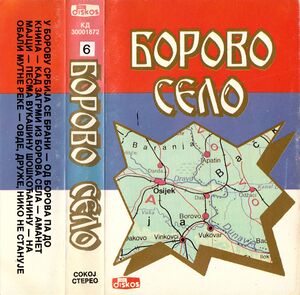 | ||||
| Studio album by | ||||
| Released | 1991 | |||
| Genre | Novokompovana | |||
| Length | 25:51 | |||
| Label | Diskos | |||
| Producer | Дафинић Миломир | |||
| Бранко Маринковић - Лалић chronology | ||||
| ||||
Borovo Selo (Serbian Cyrillic: Борово Село), also known as U Borovu Srbija se brani (Serbian Cyrillic: У Борову Србија се Брани, lit. In Borovo, Serbia defends itself) is the debut album of Serb war singer Branko Marinković -Lalić, released in 1991 by Diskos.
Background
Following the multi-party elections held in Croatia on April 22nd, 1990, the Croatian Democratic Union (HDZ) would win, with its political intentions being independence from Yugoslavia. With the political situation in the SR Croatia deteriorating rapidly and a rebirth of Croat nationalism, the Serb population feared for their safety and wanted their own independence from Croatia. The prelude to the Croatian War, the Log Revolution, came to be on August 17th, 1990 and lasted until December. Here the Serbs put up barricades strategically blockading roads with logs cut down from nearby woods, aiming to create their own state, the SAO Kninska Krajina. As ethnic tensions continued to grow, in 1991 the village of Borovo selo, a part of Vukovar municipality with a predominantly Serb population, was also barricaded on April 1st out of fear for clashes like the Plitvice Lakes incident just a day before. On April 14th there were meetings between the residents of Borovo Selo, led by Vukašin Šoškoćanin and Croatian authorities in Vukovar to secure some form of peace in the area, but to no avail as in mid-April three rockets were fired by Croat positions outside of Borovo Selo as provocation. This only fueled the fire and led to Serb paramilitaries being called by the residents out of fear for safety and protection and figures like Vojislav Šešelj agitating the already irritated population with speeches and recruiting them to fight.
On the 1st of May 1991 after Croat policemen entered Borovo Selo to replace a Yugoslav flag with the flag of Croatia, this resulted in an armed clash where two police officers were captured by Serb forces. Conflict would start on May the 2nd. After negotiations by Šoškoćanin and Croat authorities to remove the barricades and promises to resolve the conflict peacefully, two busses filled with Croat policemen entered the village. The Serbs saw this as an attack and paramilitaries promptly ambushed the two busses. Reinforcements came and a firefight ensued which lasted until 2:30pm. Twelve Croat policemen were killed and 21 injured in the ambush.
The conflict in Borovo Selo is generally seen as the start of the Croatian war.
Release
Borovo Selo was released when the Croatian war was underway and counts as one of the first cassettes made during the conflict. It was released sometime in mid-to-late 1991 by Diskos. It is Branko Marinković's first studio album and thematizes the conflict in Borovo Selo, as well as the uprisings of Serbs in the rest of Croatia. The songs are laregly sad in nature and mention the loss of homes and posessions aswell as life, but also contains songs directed against Croat forces mentioning the clashes between them and Serb forces. The instrumentation of the album reflects this as its closer to older folk albums, which makes it stand out compared to later war albums.
There are two known issues of the cassette. The first issue was printed by GIP Beograd in 1991 and has a faded cover made out of thicker paper with a reflective gold print and high audio quality. The second issue uses thinner paper, has more vibrant colors but also uses non-reflective gold print with the audio quality also being high but heavily saturated.
On November 10, 2020, the album was released on Youtube via the topic feature and digital music streaming services. The j-card used as the cover image comes from the scan provided on the music collecting site Discogs. The cover is digitally altered as the current rights holder is MINT Production. With the current state of rights within the war music genre, however, the legitimacy of the rights are questionable at best. The source of the audio used for the upload is unknown.
Track listing
All lyrics are written by Branko Marinković - Lalić except where noted.
| No. | Title | Length |
|---|---|---|
| 1. | "У Борову Србија се брани" | 2:57 |
| 2. | "Од Борова па до Книна" | 2:37 |
| 3. | "Кад загрми из Борова Села" | 2:45 |
| 4. | "Аманет мајци" | 2:23 |
| No. | Title | Writer(s) | Length |
|---|---|---|---|
| 1. | "Песма Вукашину Шошкоћанину" | 3:00 | |
| 2. | "На обали мутне реке" | 3:24 | |
| 3. | "Овде, друже, нико не станује" | Жељко Ристић | 5:21 |
| Total length: | 25:51 | ||
Personnel
Writing
- Бранко Маринковић-Лалић - Композитор (Composer), тескт и аранжмани (Lyrics and arrangement)
- Оркестар Стевана Николића (Orchestra)
- Стевива Јовановић - Хармонике (Accordion)
Production
- Дафинић Миломир - Продуцент (Producer)
- Здравко Пантелић - Извршни продуцент (Executive producer)
- Милодраг Милутиновић - Главни и одговорни уредник (Editor in chief)
Miscellaneous
Посебно се захаваљујемо Ивану и Марију
Variants
- Very good audio quality
- Faded cover
- Faded labels
- Thicker paper
- Shiny gold print
- Very good audio quality but high saturation
- GIP Beograd logo is missing on back of j-card
- Decent audio quality
- Standard J-Card paper
- Gold is non-reflective
